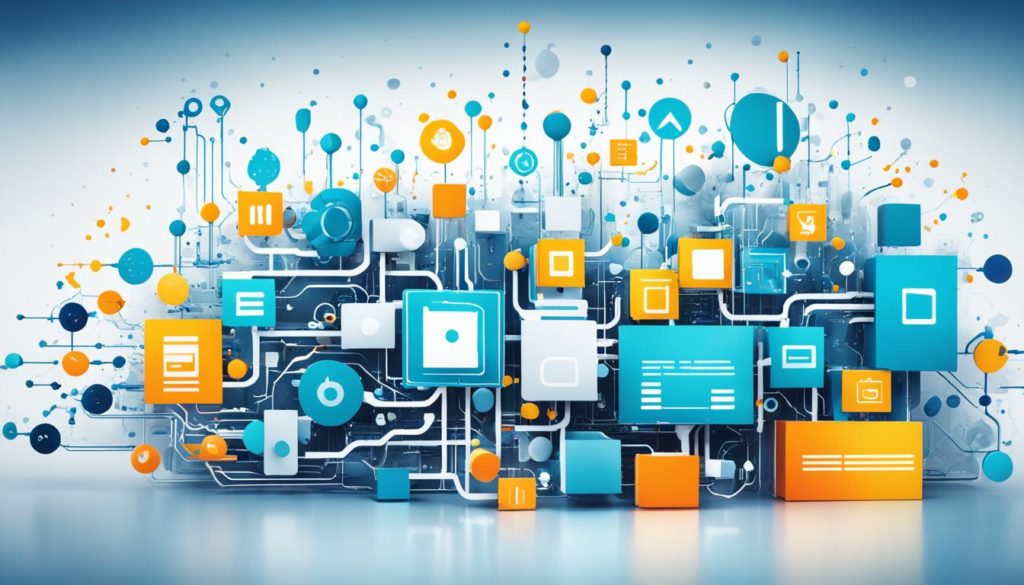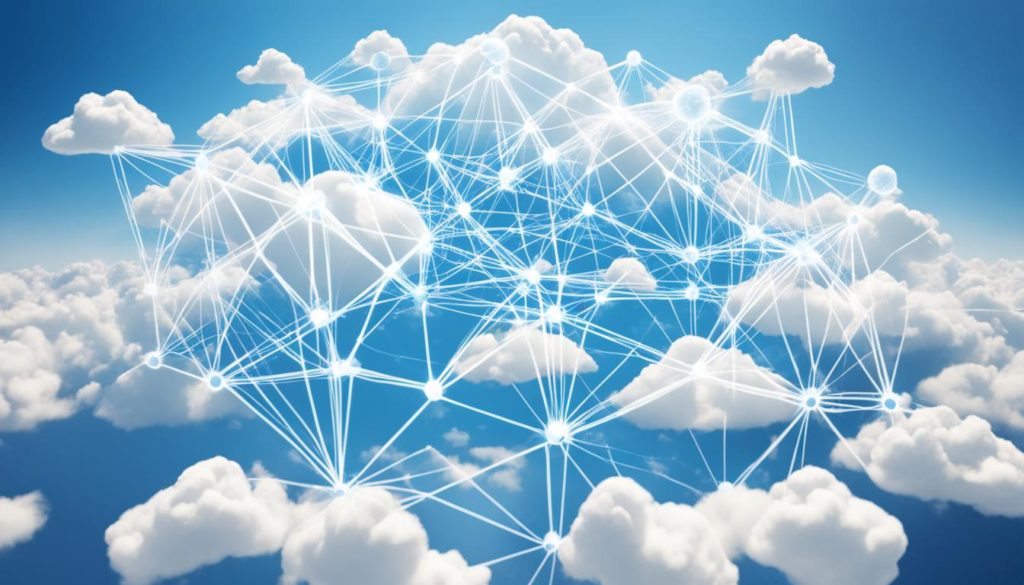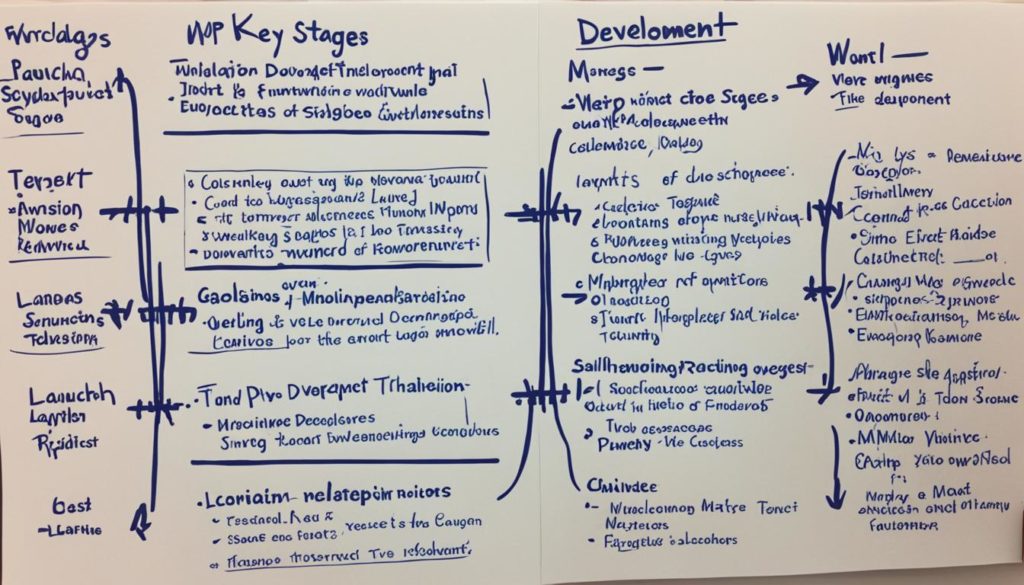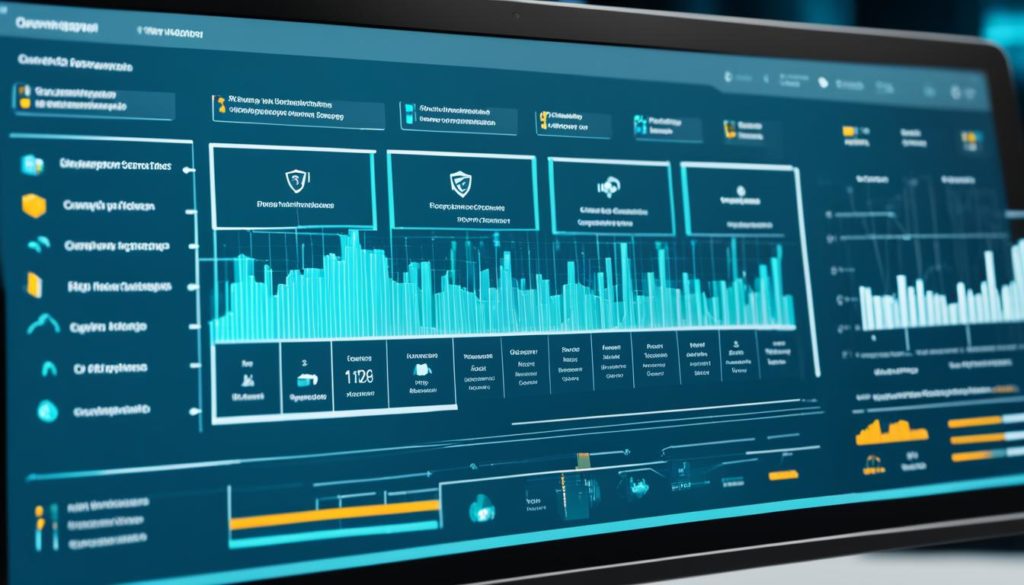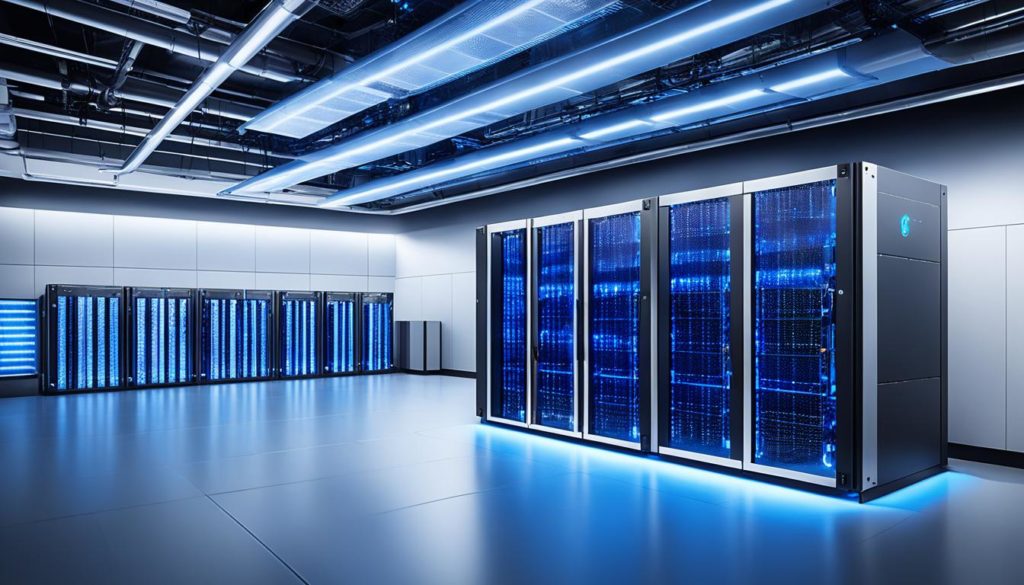
As of December 2023, the world had roughly 10,900 data center spots. This shows how important they are in the digital era. Data centers are heavily impacted by trends like cloud computing, AI, and IoT. These push for faster processing, better security, and more efficiency.
A massive 79.4 zettabytes of data is expected by 2025, putting a lot of demand on data centers. They must step up in using less energy and being more eco-friendly. This is crucial for meeting the global target of zero emissions by 2050.
Data centers are more than just buildings. They power our digital lives at work and home, making everything faster and more flexible. The balance between technology progress and being eco-friendly is critical. It will shape how data centers evolve, ensuring they meet green goals while continuing to push tech boundaries.
Key Takeaways:
- There are around 10,900 data center locations globally as of December 2023.
- Cloud computing, AI, and IoT are key drivers in the future of data centers.
- Data centers must innovate to meet energy efficiency and sustainability goals.
- Sustainability targets include achieving net-zero emissions by 2050.
- Data centers play a crucial role in processing and securing vast amounts of data.
- The predicted data generation is expected to reach 79.4 zettabytes by 2025.
Evolving Data Center Technologies
The data center world is changing fast, focusing on working better and greener. New technologies like artificial intelligence (AI) and machine learning are helping. At the same time, better cooling methods are also playing a big role.
AI and Machine Learning Integration
AI is key in making data centers smarter. By 2022, 86% of CEOs saw AI as a key tech tool. Many data centers around the world are using AI. It handles about 25% of their capacity.
AI helps guess server loads and then adjusts power use as needed. This has cut power use by 15%. It also finds servers not working hard and shifts jobs to them. This cuts waste, saving money for companies. To know more about these trends, you can follow this link data center tech trends.
Liquid Cooling Solutions
New cool tech is very important too. Old ways of cooling by air are not enough for today’s servers. Liquid cooling, like 3M’s Novec, is better at getting rid of heat. This saves a lot of energy and makes cooling more efficient. Google, for example, has lowered its cooling costs by 40% with AI-based cooling. The move towards advanced cooling technologies shows the benefits for the planet and wallets.
As data centers keep growing, we need to use these new technologies. They help meet the needs for more power and better operations. The use of AI and new cooling methods put data centers on a good track for the future.
Sustainable Data Centers
Working with sustainable data centers is key in our eco-friendly journey. New hardware and green energy are vital here. They lessen our environment impact, boost efficiency, and use less energy.
Energy-Efficient Hardware
Companies push hard to make hardware that uses less power. This includes CPUs, memory, and storage. Though they use less energy, they still perform well. The goal is for the green data center market to hit $975 billion by 2036. So, the push for green tech is strong.
Renewable Energy Adoption
Switching to renewable power is a turning point for data centers. Now, many use green energy and stay effective. WindCORES centers get most power from nearby wind turbines. Amazon and Google are leaders, using only green power. This shows a big step towards a greener future.
Future of Data Centers
Data centers are moving towards higher rack density and more efficiency. They are keeping up with our need for powerful computers. This step is crucial for the future.
Increasing Rack Density and Efficiency
By 2027, racks are expected to handle 50kW, up from the current 36kW. This jump meets the heavy demands on today’s technology. The aim is to make data centers use power more wisely while boosting performance.
Edge Computing Integration
Edge computing is becoming key, with 29% of enterprise data centers adopting it by 2022. As more IoT devices come out, we make more data. Edge computing helps handle this data quickly. It also makes data centers more efficient and flexible in a world where edge and cloud computing work together.
Hyperconverged and Composable Infrastructure
In the future, hyperconverged infrastructure (HCI) and composable infrastructure are key for data centers. Hyperconverged brings together computing, storage, and networking for simplicity and better scalability. Meanwhile, composable infrastructure lets you use resources on the fly, adapting quickly as data needs change.
Hyperconverged data centers save money and are easier to manage. They use the latest tech, like SSDs, for top performance. This makes them perfect for more places, like at the edge of networks. And they work smoothly with different clouds, ensuring things run well no matter where you store data. Hyperconverged solutions really shine for virtual desktops, especially those in the cloud.
Composability adds another layer to HCI. It makes sharing resources easier and allows for quicker setups using software. This kind of setup is perfect for data-heavy businesses that need to grow fast. Plus, its approach means smoother operations and easier planning for today’s data centers.
Using both types of infrastructure is a big win for businesses. They help data centers stay fast and flexible in a changing digital world. They also pair well with technologies such as AI and machine learning. This can improve how data centers are run, making everything smarter and more efficient.
Hyperconvergence
Hyperconvergence is changing how data centers work. It cuts the need for pricey gear by using cheaper options that still work well. It can support up to 30 systems in one group. This simplifies things and makes data centers more effective. Experts predict it will grow a lot, reaching $32 billion by 2028.
It’s also set to make the most out of edge computing and handle lots of data from IoT devices. The move to software-defined everything has made HCI even more useful. It offers flexible storage, networking, and computing, which is great for many settings.
Data centers need to pick their tech investments wisely. Doing tests can help check how well different options meet needs. Composable infrastructure lets you set up servers just the way you need them. This is key for making sure data centers can keep up with change.
| Key Metrics | Hyperconverged Infrastructure (HCI) | Composable Infrastructure |
|---|---|---|
| Scalability | Up to 30 nodes | Virtually unlimited |
| Cost Efficiency | Reduces need for specialized hardware | Optimizes resource allocation |
| Performance | Optimizes with SSDs and NVMe | Dynamic resource sharing |
| Management | Unified, simplified interface | Software-defined management |
| Best Suited For | Edge computing, hybrid cloud | On-demand resource allocation |
Advancements in Energy Storage
Energy storage is getting better and key for green data centers. It uses new methods like batteries, flywheels, and hydrogen cells. These technologies help make energy supply stronger and more reliable. They store extra energy when not needed for later use. This way, data centers can rely less on the main energy grid. Plus, it fits their goals of using more renewable energy.
Batteries and Flywheels
Batteries and flywheels are leading the way in energy storage. Lithium-ion and solid-state batteries are key leaps in battery tech. They offer a good and steady way to save energy. Flywheels store energy from motion and turn it directly into power, improving how smoothly power flows in data centers. Together, these options cut down on energy loss and provide steady power.
Hydrogen Fuel Cells
Hydrogen fuel cells are a game-changer for data centers. They change hydrogen into electricity, making only water vapor as waste. This tech is both green and great for making sure there’s enough energy. Over time, hydrogen fuel cells will be very important for data centers trying to be more sustainable. They can store extra energy from wind or solar, which makes them even more valuable.
Smart and Sustainable Data Center Solutions
The future is all about tech advancements. It’s vital to choose smart data center solutions. These should be both efficient and eco-friendly. Sustainable data center infrastructure is key. It helps reduce harm to the environment while making work smoother.
Dynamic Cooling Systems
Next-gen tech like liquid cooling is changing how we deal with heat in data centers. These systems remove heat better and allow for tighter machine layouts. This means more computing power in the same space. Big names like Microsoft and Facebook use liquid immersion cooling. It shows the benefits and efficiency of these methods. Updating data center software can cut down on cooling needs too. This is done by using constant checks and cooling plans for smarter power use.
Power Distribution Management
Managing power intelligently is key for today’s data centers. It ensures energy is used well. Leaders like Google and Amazon are focusing on green energy for their needs. Since 2007, Google has offset its carbon footprint. It aims to have all its energy from renewable sources. Amazon Web Services (AWS) plans to do the same by 2025. This shows their dedication to eco-friendly data center setups.
Using smart power management systems makes data centers more efficient and eco-friendly. Companies like Schneider Electric and Equinix are leading this charge. The industry is making steady progress towards smarter, greener operations. The push for smart solutions and green power shows how important these ideas are for the future.
For more on sustainable data centers, check out this comprehensive resource.
| Company | Renewable Energy Adoption | Sustainability Goals |
|---|---|---|
| 100% Renewable Energy | Carbon Neutral since 2007 | |
| Amazon Web Services | 100% by 2025 | 5 Years ahead of 2030 target |
| Microsoft | Reduced Scope 1 & 2 emissions by 17% | Carbon Negative, Water Positive, Zero Waste by 2030 |
| Equinix | Climate Neutral Data Centre Operator Pact | Over 210 Data Centers globally |
To learn more about sustainability in data centers, visit this link. For in-depth coverage on green data centers, check out this source.
Conclusion
Data centers are crucial as we use more technology. By 2025, we will have over 175 zettabytes of data. This makes managing data very important. We need to do this in a way that does not harm our planet.
Investments are growing in making data centers more green. This market could be worth $57 billion by 2025. Companies like Facebook and Google are pushing for cleaner practices. For example, Facebook is investing heavily in a Virginia data center. Both Google and Facebook have projects benefiting from green tax breaks.
These companies are using more renewable energy. They pick locations close to clean and cheap power sources. Things like Sweden’s 97% tax cut on electricity make eco-friendly locations more appealing. This is good because it helps the environment.
Using green technology means being smart about energy and cooling. Data centers in cool places like Northern Sweden can save a lot on cooling costs. They even use seawater to cool servers. This helps save energy.
Increasing connectivity is also key. The world will spend almost $150 billion on fiber-optic cables this year. This shows how important fast and reliable connections are for data centers. They help balance global growth and local needs.
Key players are making big commitments toward greener data centers. They are making smart investments. The goal is to help data centers run well without hurting the planet. By doing this, they also help the world reach its green goals.
FAQ
How is the future of data centers evolving with technological advancements?
The future of data centers looks bright with fast processing, better security, and more efficiency. We see AI and Machine Learning, cooling with liquids, and a drive for cooler, more efficient spaces.
What impact does cloud computing have on data centers?
Cloud computing has changed data centers by moving data storage off-site. It lessens the need for as much physical space and allows for growth. This way, businesses can handle large amounts of data in a flexible way.
How are AI and Machine Learning being integrated into data center operations?
AI and Machine Learning make data centers work better by guessing server loads. They also save energy by finding servers not fully used. Then, they move tasks around to use that power.
What are the benefits of liquid cooling solutions in data centers?
Liquid cooling, such as 3M’s Novec, helps fight overheating from more work being done. It’s key in using less energy and making data centers more efficient.
Why is building sustainable data centers important?
Green data centers matter for our planet, cutting down on energy waste and pollution. They use clean energy and tech that doesn’t harm the Earth. This means they help save the environment.
How are renewable energy practices being adopted in data centers?
Big tech firms like Amazon and Google push to use only clean energy. Places like windCORES help a lot, using lots of wind power. This cuts back on fossil fuels and helps the Earth.
What is the projected growth for the green data center market?
There’s big growth expected, with green data centers valued at 5 billion by 2036. This rise is due to wanting more energy-friendly storage options and greener ways of working.
How is edge computing impacting data centers?
Edge computing deals with data where it’s made, making quick action possible and cutting wait times. It’s very helpful with the data boom from IoT and makes data centers work smarter and faster.
What are hyperconverged and composable infrastructures?
Hyperconverged pulls together computing, storage, and networking for an easier setup. Composable lets you add resources as you need them, keeping up with new data needs without a lot of hassle.
How are advancements in energy storage benefiting data centers?
Better ways to store energy, like batteries and fuel cells, make data centers ready for anything. They help keep energy use in check and lessen the need for outside power, which is good for the environment.
What role do smart and sustainable solutions play in data centers?
Smart tech, like AI and efficient cooling, saves on energy and adapts as needed. New cooling and renewable power ways are key for lasting, efficient data centers.
Future App Studios is an award-winning software development & outsourcing company. Our team of experts is ready to craft the solution your company needs.



